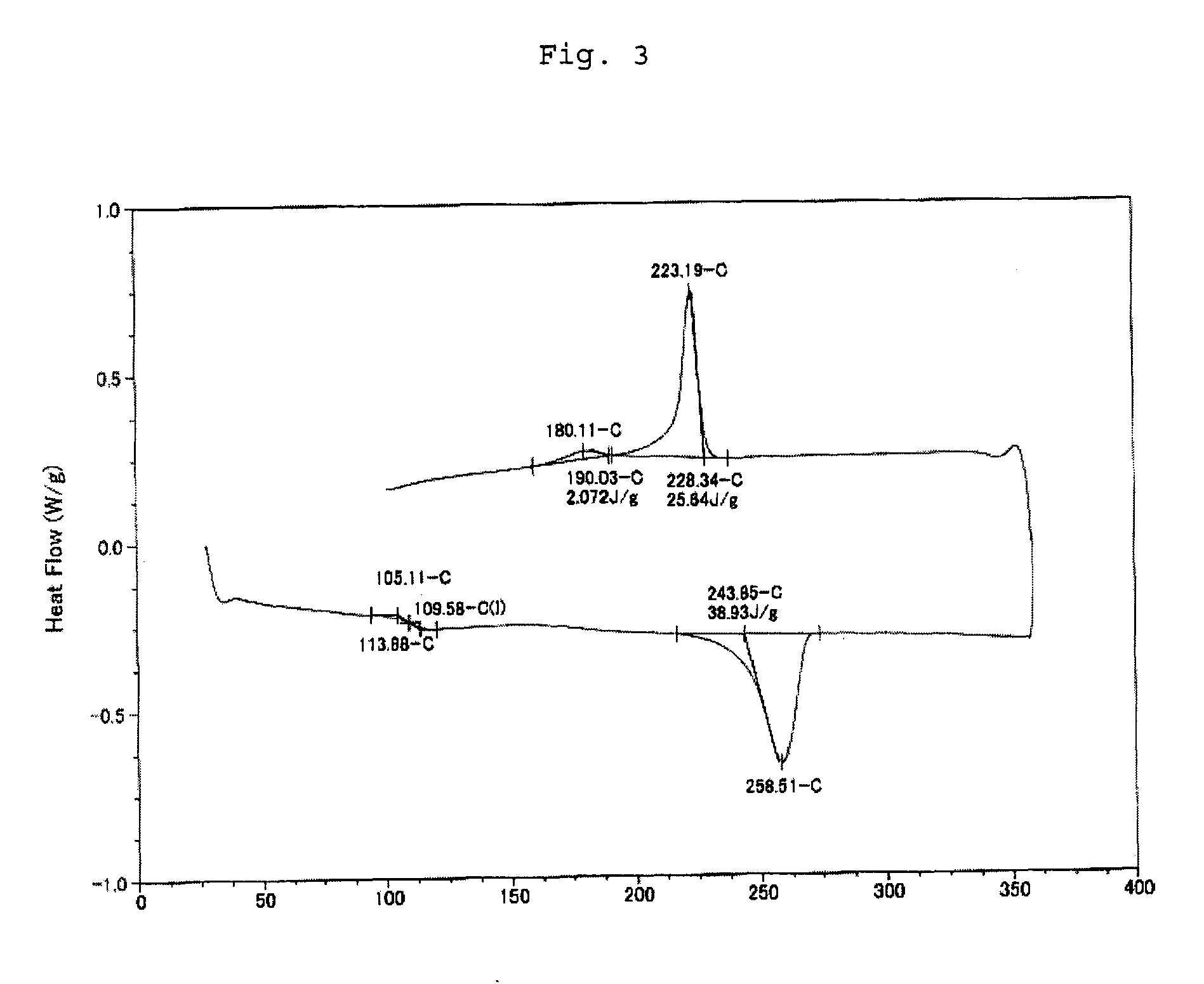Aromatic polyester and manufacturing process thereof
a technology of polyester and manufacturing process, applied in the field of aromatic polyester, can solve the problems of difficult to obtain biaxially oriented films like polyethylene terephthalate, difficult to handle, difficult to say that they have satisfactory properties depending on application purpose, etc., and achieve excellent mechanical properties, excellent heat resistance and color, excellent mechanical properties
- Summary
- Abstract
- Description
- Claims
- Application Information
AI Technical Summary
Benefits of technology
Problems solved by technology
Method used
Image
Examples
first embodiment
[0040]An aromatic polyester (1) comprising a dicarboxylic acid component which contains a recurring unit represented by the following formula (A-1) (R is an ethylene group in the formula (A)) as the main constituent and having a melting point of 295° C. or higher is preferred as the aromatic polyester. The expression “as the main constituent” means that the content of the recurring unit is preferably 90 to 100 mol %, more preferably 95 to 100 mol %, much more preferably 99 to 100 mol %.
[0041]The diol component of the aromatic polyester (1) contains the recurring unit represented by the following formula (C) in an amount of preferably 90 to 100 mol %, more preferably 95 to 100 mol %.
—O—CH2CH2—O— (C)
[0042]Other diol components include the recurring unit represented by the following formula (C-1).
—O—Rc—O— (C-1)
[0043]In the formula (C-1), Rc is an alkylene group having 3 to 8 carbon atoms. Examples of the alkylene group include isopropylene group, trimethylene group, tetramethylene gr...
second embodiment
[0046]An aromatic polyester (2) comprising a dicarboxylic acid component which contains 50 to 80 mol % of the recurring unit represented by the formula (A) and 50 to 20 mol % of a recurring unit represented by the following formula (B-1) and having a melting point of 225 to 265° C. is preferred as the above aromatic polyester.
[0047]The diol component contains the recurring unit represented by the following formula (C) in an amount of 90 to 100 mol %, preferably 95 to 100 mol %, more preferably 98 to 100 mol %.
—O—CH2CH2—O— (C)
[0048]Other diol components include the recurring unit represented by the following formula (C-1).
—O—Rc—O— (C-1)
[0049]In the formula (C-1), Rc is an alkylene group having 3 to 8 carbon atoms. Examples of the alkylene group include isopropylene group, trimethylene group, tetramethylene group, hexamethylene group and octamethylene group.
[0050]The aromatic polyester (2) has an intrinsic viscosity measured at 35° C. by using a mixed solvent of P-chlorophenol and 1...
third embodiment
[0058]An aromatic polyester (3) comprising a dicarboxylic acid component which contains 50 to 80 mol % of the recurring unit represented by the formula (A) and 50 to 20 mol % of a recurring unit represented by the following formula (B-2) and having a melting point of 235 to 270° C. is preferred as the above aromatic polyester.
[0059]The diol component contains the recurring unit represented by the following formula (C) in an amount of 90 to 100 mol %, preferably 95 to 100 mol %, more preferably 98 to 100 mol %.
—O—CH2CH2—O— (C)
[0060]Other diol components include the recurring unit represented by the following formula (C-1).
—O—Rc—O— (C-1)
[0061]In the formula (C-1), Rc is an alkylene group having 3 to 8 carbon atoms. Examples of the alkylene group include isopropylene group, trimethylene group, tetramethylene group, hexamethylene group and octamethylene group.
[0062]The aromatic polyester (3) has an intrinsic viscosity measured at 35° C. by using a mixed solvent of P-chlorophenol and 1...
PUM
| Property | Measurement | Unit |
|---|---|---|
| Temperature | aaaaa | aaaaa |
| Fraction | aaaaa | aaaaa |
| Fraction | aaaaa | aaaaa |
Abstract
Description
Claims
Application Information
 Login to View More
Login to View More - R&D
- Intellectual Property
- Life Sciences
- Materials
- Tech Scout
- Unparalleled Data Quality
- Higher Quality Content
- 60% Fewer Hallucinations
Browse by: Latest US Patents, China's latest patents, Technical Efficacy Thesaurus, Application Domain, Technology Topic, Popular Technical Reports.
© 2025 PatSnap. All rights reserved.Legal|Privacy policy|Modern Slavery Act Transparency Statement|Sitemap|About US| Contact US: help@patsnap.com



